Cortona’s appeal lies in its lofty setting, splendid views and medieval mood. Set close to the Umbrian border, 30 km south of Arezzo, Cortona is one of the most delightful hill towns in Tuscany. It was founded by the Etruscans, colonised by the Romans, and, after its sale to the Florentines in 1409, thrived under the Grand Duchy of Tuscany. Cortona is perched majestically on a ridge of Monte Sant’Egidio, dominating the Val di Chiana. The approach road winds through terraced olive groves and vineyards, past villas, farms and monasteries.
Cortona is a tourism hotspot so its over-popularity is a given. The city’s slow burn was accelerated after the town found fame in Under the Tuscan Sun, a book which led to a film and a summer festival. Even so, once beyond the main squares, the crowds thin out. Luckily, there are enough quaint inns to restore any grumpy spirits.
Cortona
-
-
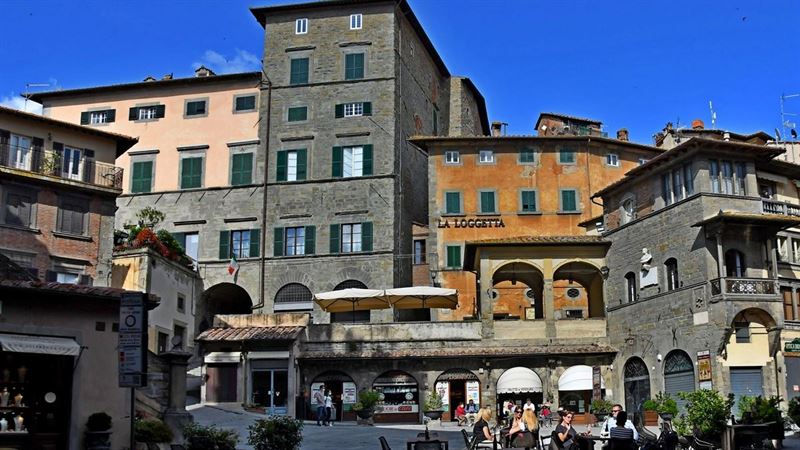
Top Ten Things To Do - Cortona
With few must-see sights, Cortona is about wandering at your own pace and lapping up the views and medieval mood. Much depends how far you want to climb as the crowds disappear once you head upwards along incredibly steep streets. More mellow pleasures include indulging in an ice-cream and a passeggiata around the main squares. Popular day trips can take you north to Arezzo or south to Lake Trasimeno.
-
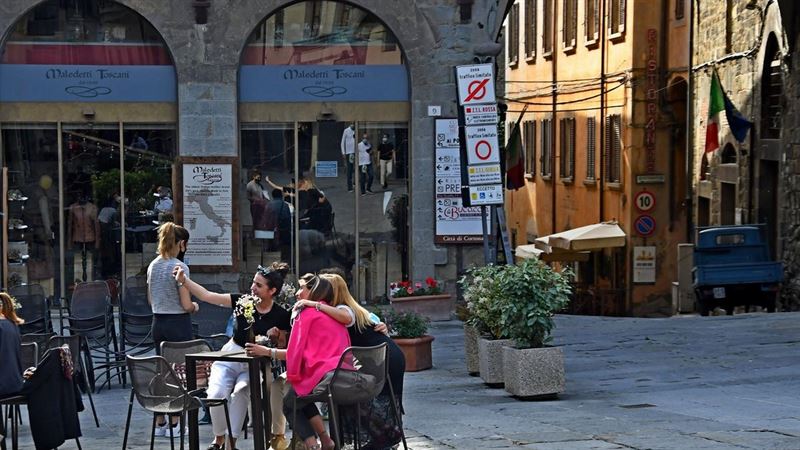
1. Piazza della Repubblica & Piazza Signorelli - to take the city pulse
Cortona’s ancient city gateways lead to a self-indulgent stroll along medieval streets, monuments and bustling squares. Begin a walking tour in the heart of town, in the delightfully asymmetrical Piazza della Repubblica and Piazza Signorelli, once home to the ancient Etruscan-Roman forum but now the site of the Saturday morning market. Visitors congregate in these two squares, a pedestrianised zone made for people-watching. Take the city pulse while sipping a coffee, listening to the talented buskers, or browsing for arty trinkets. Named after local painter Luca Signorelli, Piazza Signorelli boasts the 13th-century Palazzo Comunale (Town Hall) and Cortina’s Etruscan Museum, the Museo dell’Accademia Etrusca . Conveniently, the local tourist office is housed in the same mansion.
Address: Cortona tourist office, Palazzo Casali, Piazza Signorelli, 9, Cortona
Web: www.cortonaweb.net -
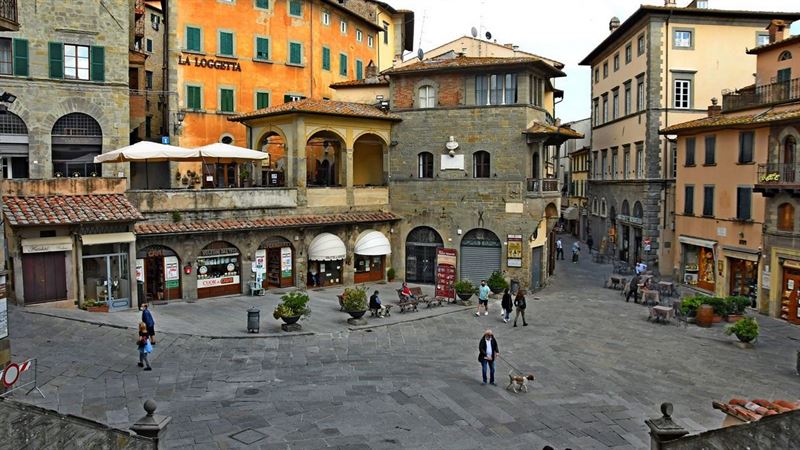
2. Museo dell’Accademia Etrusca - for Etruscan Cortona
Set in the 13th-century Palazzo Casali, which incorporates Etruscan walls, the Etruscan Academy is the place to get to grips with the city’s ancient origins. The museum, set just behind the Palazzo Comunale, is a reminder that Cortona, enclosed by stone walls dating to Etruscan and Roman times, was the most important Etruscan city in the north of Tuscany. The highlight is a -genuine Etruscan chandelier dating from the 5th-century BC, with the lamps representing dolphins, gorgons and stylised waves. There is also a recreation of the interior of an Etruscan tumulus, the Secondo Melone di Sodo. These and other finds come from Etruscan tombs in Sodo, just outside town. Equally lovely is the fresco of Polymnia, considered to be a fine Roman painting of the Muse of Song until recent research suggested it was an 18th-century forgery. This eclectic and underrated museum covers more than Etruscan and Roman finds and strays into Egyptology, 18th-century decorative arts and even Futurism. Gino Severini, a leading Futurist artist, was born in Cortona and his works are on display here.
Address: Piazza Signorelli 9, 52044 Cortona
Web: www.cortonamaec.org -
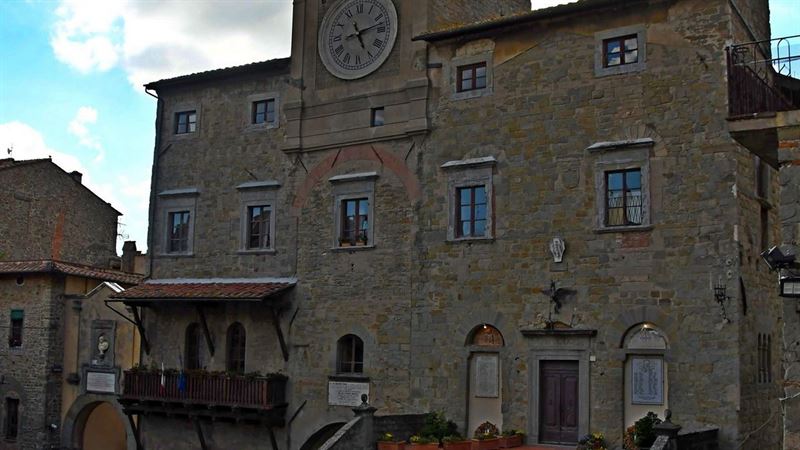
3. Museo Diocesano - for memorable religious art
Across from the Duomo, the 16th-century Cathedral is its companion, the Museo Diocesano, set in the former oratory and church of Gesu. Unlike the disappointing cathedral, which has been disfigured, the Diocesan Museum is a treasure house in miniature. On display are rare masterpieces by Fra’ Angelico, Lorenzetti and local boys Luca Signorelli and Pietro da Cortona. The star exhibit is Fra’ Angelico’s Annunciation, a luminous version of the angel messenger created in the 1430s in shimmering gold leaf. Luca Signorelli (1450–1523), one of a number of celebrated artists from Cortona, was inspired by his master, Piero della Francesca. Signorelli produced frescoes for Orvieto Cathedral and was summoned to the Vatican to complete frescoes in the Sistine Chapel. Signorelli’s works on display here include the poignant Lamentation over the Dead Christ. Other highlights include a Sienese Madonna by the school of Duccio Madonna, a 14th-century Pietro Lorenzetti Crucifix, and a Roman sarcophagus that inspired Donatello.
Address: Piazza del Duomo 1, 52044 Cortona
Web: www.cortonaweb.net/en/museums/diocesan-museum -
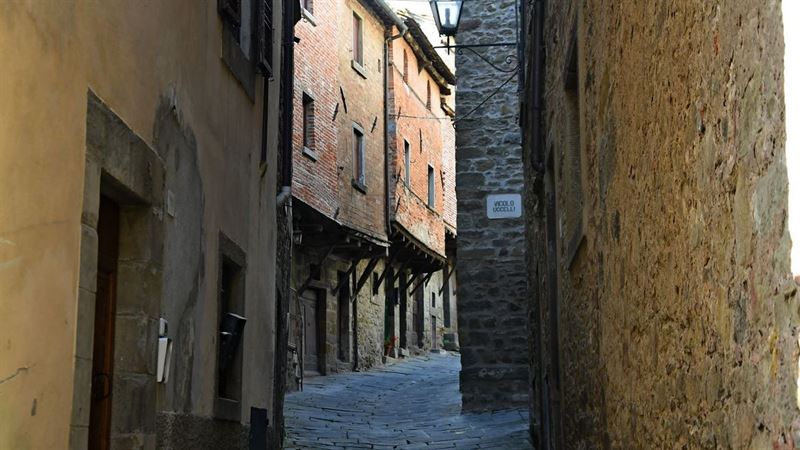
4. Medieval meanderings
Cortona, riddled with medieval alleyways, is a place for meandering rather than ticking off key sites. Now that Cortona is an insider secret no longer, the city’s quaintly crooked, cobbled streets can be awash with summer visitors. Crowds in Cortona are nothing new, especially since an American author gave it a further boost. The city is famous for being the setting of the bestselling book, Under the Tuscan Sun, by Frances Mayes. Escape the crowds by seeking out Via Janelli for its row of brick buildings with overhanging upper storeys – some of Tuscany’s oldest surviving medieval houses. Other picturesque streets include via Ghibellina and via Guelfa, with their medieval mansions.
On a higher level, you can also visit the monumental complex of San Francesco, a short walk up from Piazza della Repubblica. San Francesco, encompassing a 13th-century church and the monastery, displays a fresco by Pietro da Cortona. Continue ever upwards to reach the higher part of the town, with its narrow streets and medieval buildings. In the heart of the medieval district, San Nicolò houses Signorelli’s wonderful standard of the Deposition. The steep, crooked streets, linked by stone staircases, work their way painfully to the Medici fortress at the top.
Web: www.cortonaweb.net -
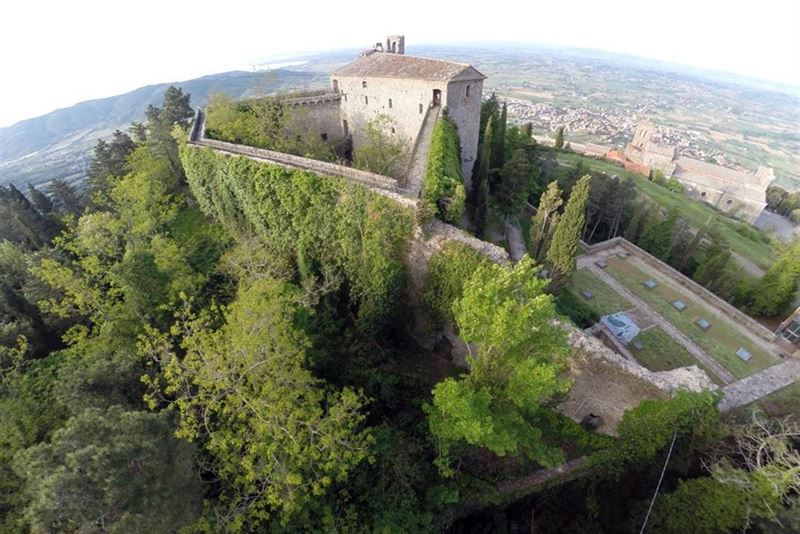
5. Hike to the upper town
Be prepared for a hike to the views at the top by the Medici fortress, the Fortezza del Girifalco, which occupies the site of the Etruscan acropolis. Set high above the Valdichiana plain, Cortona surveys terraced slopes of olive groves and vineyards. This perfect medieval town is deservedly popular but escape the summer crowds for this lofty setting. Set on a rocky spur 600 metres above sea level, Cortona climbs upto a Medici fortress and uplifting views of both Lake Trasimeno and Monte Amiata.
First of all, it’s a steep climb up to the Basilica di Santa Margherita, on Piazzale Santa Margherita, dedicated to the city’s patron saint, a follower of St Francis. The citizens of Cortona still make pilgrimages up the winding stone-flagged streets to her tomb to offer her prayers during hard times.
The Medici Fortress above is somewhat overgrown, but the views from up here are splendid, and it’s a tempting spot for a picnic. The fortress is a fine example of military architecture, rebuilt in the 16th-century under Cosimo I de’ Medici’s rule. Writer Henry James admired this “crumbling citadel” but it has now been salvaged for the town. After major restoration, the fortress re-opens by summer 2018 as a cultural centre, complete with photographic exhibitions, jazz concerts, a bistrot and wine bar.
Web: https://www.fortezzadelgirifalco.it/index_eng.php -
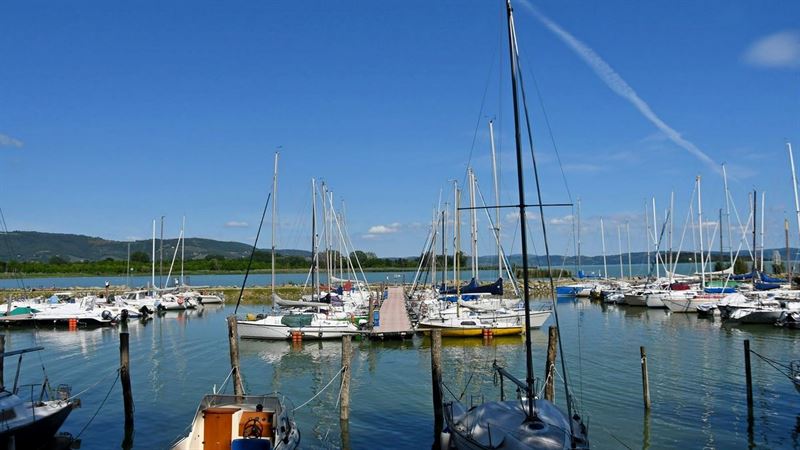
6. Lake Trasimeno - for its languid pace of life
One side of Cortona’s public gardens opens to a belvedere with sweeping views south, enveloping the Lago di Trasimeno, Italy’s fourth-largest lake, which lies in neighbouring Umbria. The lake remains off the well-beaten tourist trail so come for the restful scenery and languid pace of life. Its shallow waters are surprisingly clean and popular with swimmers, boaters and windsurfers. There was a day, though, in 217 BC when the lake waters ran red with the blood of the Roman legions, more than 16,000 of whom were slaughtered by Hannibal’s troops. Even in these small fishing villages, the lake's fortifications attest to its strategic location and turbulent past.
Today the scene is considerably more peaceful, especially on the southern shore, with Castiglione del Lago the place to toast farewell to underrated Arezzo province over a lakeside fish feast. Visit this foodie hotspot for a feast of tench, perch, whitebait and eels, or drink in the Colli di Trasimeno wines. Castiglione del Lago, the lake’s engagingly touristy capital, is a castellated medieval town strung out along a charming promontory. Although founded by the Etruscans, this fortified village feels resolutely medieval, with splendid views from the ramparts of the 14th-century castle.
The lake also offers pleasant drives, walks and cycle rides with views of sunflower fields, shimmering vineyards, silvery olive groves, oak woods and billowing cypresses. The cycle route around the lake is a classic ride, with the chance to explore Castiglione del Lago, Passignano and Sant’Arcangelo. This foodie-minded lake also provides ample opportunities for wine and olive oil tasting en route. The Passignano stretch offers views of meadows and woodland from the crest of a hill. The shortest, most appealing stretch of the cycle route hugs the shore between Castiglione and Tuoro.
Address: www.umbriatourism.it -
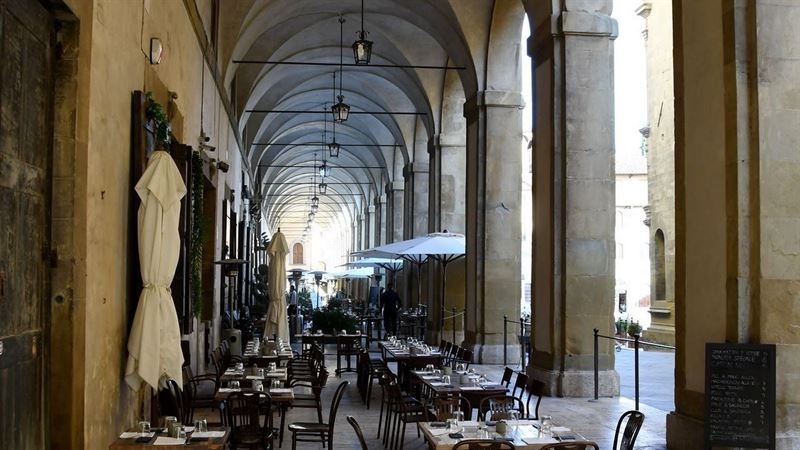
7. Arezzo - for city culture, uplifting art and shopping
Underrated Arezzo, 30 km north of Cortona, makes for a surprising day trip. The rolling countryside reveals pan-tiled farmsteads flanked by clusters of dark-green cypresses. Even more pleasurable is the city itself. Arezzo has not sold its soul to tourism. Despite its art-studded churches, tourism is muted in a hidden gem of a city that has, literally, built its fortune on gems. Gold, in particular, has brought wealth to Arezzo since Etruscan times and the city is still popular for lovers of fine jewellery. Arezzo was a major town in the Etruscan federation, thanks to its strategic position on a hill at the meeting point of three valleys. Today, it’s a wealthy commercial centre, dotted with jewellers, goldsmiths and antique shops.
Arezzo’s main attractions are its magical main square and its churches, often linked to Piero della Francesca. Medieval monuments cluster to¬gether in the northern part of Arezzo, including the Duomo, sheltered by the encircling walls of the 16th-century Fortezza, now a park with fine views.
But the best thing to do in Arezzo is simply to appreciate life in a Tuscan city that does not define itself by tourism. Piazza Grande, the sloping main square, has been at the heart of city life since medieval times. The lopsided main square is a magnet for celebrations and strolls, as is the neighbouring Corso Italia. Compared with Cortona, this bold, café-lined square feels more peaceful. Admire the porticoes of the 16th-century Palazzo delle Logge Vasariane before retreating to a café, such as Caffe Vasari (at number 15). Come for the weekend antiques market, which covers the square and spills into the cobbled Corso Italia, the city’s main shopping street.
Culturally, the city belongs to Piero della Francecsa, the artist who has most left his mark on Arezzo. For art-lovers, Arezzo’s star attraction is Piero della Francesca’s painstakingly restored fresco cycle in the barnlike Basilica of San Francesco. If time, consider stopping at Castiglion Fiorentino on the way back to Cortona.
Web: www.visitarezzo.com -
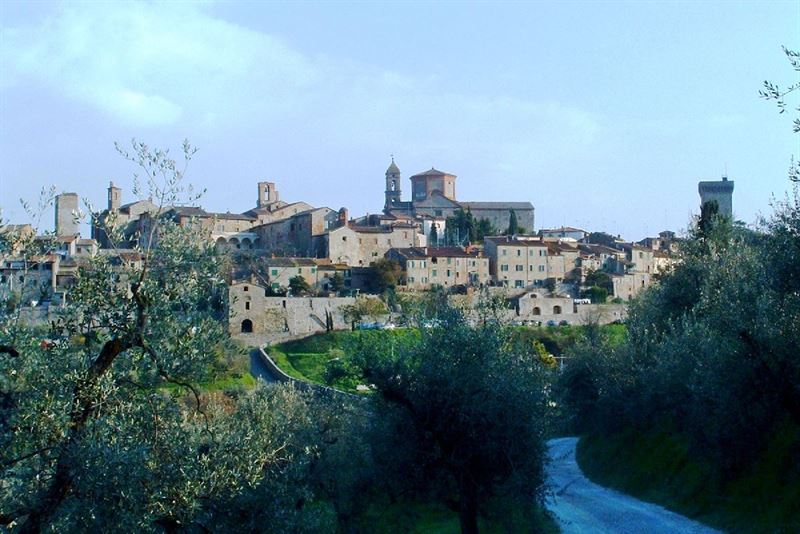
8. Val di Chiana - a taste of authentic Tuscany
Lucignano, 37 km west of Cortona, offers a taste of the Val di Chiana, famous for its beef, often found in Florentine steaks. Lucignano is surrounded by hills and picturesque towns that dot the fertile Val di Chiana plains. The town itself enjoys a commanding view of the Val di Chiana - and its snug medieval walls add to its impact. Originally an Etruscan stronghold, Lucignano is a surprising spot: the concentric arrangement of streets around a fortress make it unique among Tuscan hill towns. The egg-shaped medieval town plan surrounds the 14th-century Palazzo Comunale. Inside are frescoes from the Sienese and Aretine schools, as well as finely worked gold ornaments for which the province of Arezzo has long been famous. The best-known artefact is the beautiful 14th-century Tree of Lucignano, richly embellished with jewels. With few exceptions, Lucignano’s buildings are perfectly preserved, as is the grey-and-white-striped Gothic church of San Francesco. To avoid an overload of culture, dine in Il Goccino, enjoying lovely views from the terrace. Expect modern Tuscan cooking, all locally sourced, from the beef tartare and T-Bone steak to the basil sorbet and olive oil.
If time, take in the fortified villages of Marciano della Chiana, 6 km northeast. Much of the castle remains intact, as do the walls and a gateway with its own clock tower. Three km to the southeast is the octagonal chapel of Santa Vittoria, designed by Ammannati to mark the spot where the Florentines defeated the Sienese in 1554.
Web: www.ilgoccino.it -
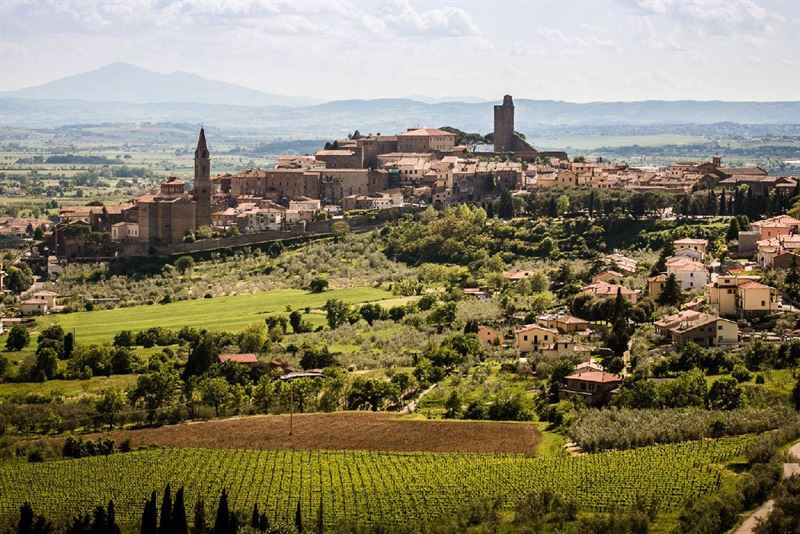
9. Castiglion Fiorentino – en route between Cortona and Arezzo
Set on the last hill overlooking the Val di Chiana plain between Cortona and Arezzo, Castiglion Fiorentino is an untouristy Tuscan borgo. Seen from afar, this fortified village looms large in the distance. It was a stronghold belonging to Arezzo until the Florentines snatched it in 1384. Today, Castiglion Fiorentino still feels very medieval, bounded by thick walls and crowned by the Cassero, a hulking medieval fortress. Even so, Renaissance touches abound. On the old market square are Vasari’s famous loggias, with stone arches framing a fine vista of the rooftops and surrounding countryside. This well-preserved medieval settlement has an unusually high number of churches. The oldest of these, the Pieve Vecchia, displays a Signorelli fresco of the Deposition of Christ (1451), while the Romanesque-Gothic church of San Francesco contains a sculpted version. Other sacred works and gold and silverware from the surrounding churches can be seen in the quirky collection in the Pinacoteca, on via del Cassero. Just outside the village is the octagonal temple of Santa Maria della Consolazione.
Looming beyond the village, and visible from the Cassero fortress, are the dilapidated battlements of the Castello di Montecchio Vesponi. This crenellated medieval castle once belonged to the legendary English condottiero John Hawkwood, a 14th-century captain and commander. After serving the Florentines well, the former mercenary became an honorary Florentine citizen.
Address: Torre del Cassero, via del Tribunale, Castiglion Fiorentino
Web: www.museicastiglionfiorentino.it -
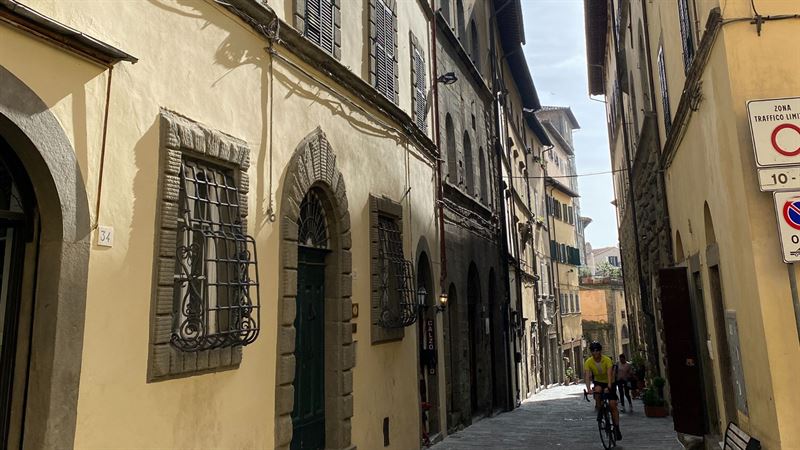
10. Parco Archeologico del Sodo - Etruscan site
This one is for hard-core fans of Etruscan culture. Ancient tombs pepper the plains around Cortona. At the bottom of the hill, an archaeological park, the Parco Archeologico del Sodo, showcases the Etruscan Sodo Tombs, including a sculpted sacrificial altar. The contents of many tombs are now in the Museo dell’Accademia Etrusca but the original sites are here. The so-called “Meloni” are ancient Etruscan tumuli found in the Sodo area, just outside Cortona. Between the 8th and 4th centuries BC “Etruria Propria” flourished as a confederation of 12 city-states in Central Italy. Northern Etruria, roughly equivalent to modern Tuscany, included Cortona, Arezzo, Chiusi, Populonia, Vetulonia and Volterra. To make sense of the Archaeological Park, it’s best to visit the area with a guide or to book a half-day weekend tour through the Museo dell’Accademia Etrusca.
Address: Parco Archeologico del Sodo, Sodo di Cortona, 52044 Cortona
Web: cortonamaec.org/it/il-parco-archeologico/ -
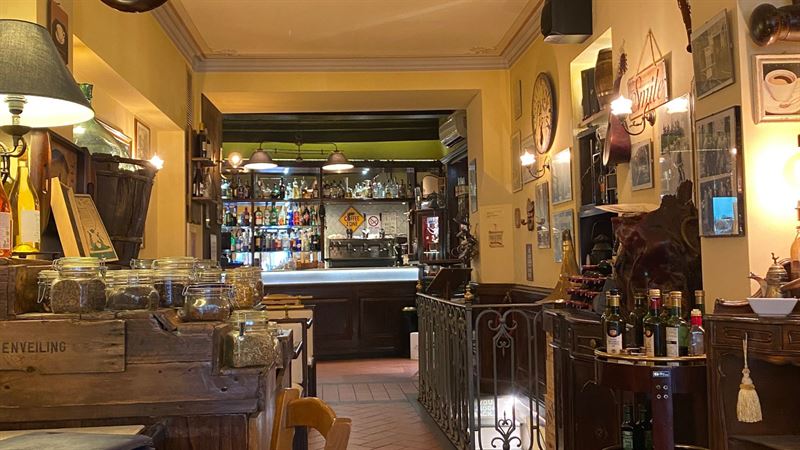
Eating and Drinking
Local cuisine from Cortona is a hearty variant on classic Tuscan cuisine, with Val di Chiana beef definitely on the menu. For any beef-loving Tuscan, bistecca alla fiorentina – a huge, tender Val di Chiana T-bone steak, grilled over an open fire and seasoned with nothing more than crushed peppercorns, salt, and a hint of garlic and olive oil, served very rare – is the ultimate steak. The Val di Chiana, the most extensive valley in the Apennine range, is the fertile farmland mainly used for cattle-rearing. Here graze herds of one of Italy’s most prized breeds of beef cattle – the Chianina, which is native to Tuscany. The cream-coloured Chianina cow grows quickly to a large size, so that it is butchered when the steer is a grown calf. The meat is firm and tasty, with a distinctive flavour.
Also on the menu are chicken liver crostini, panzanella peasant salad, fennel flan, stuffed courgettes (zucchini), tagliatelle with ceps (porcini mushrooms) or stubby pici pasta in a meaty ragu sauce. For mains, expect wild boar stew, roasted rabbit, jugged hare or boar, along with that famous steak. The local cooking is not for wimps. That said, Cortona’s elevation in the popularity stakes means that sophisticated fine dining options can also embrace fusion cooking or creative contemporary Tuscan cuisine. Discover some good Tuscan recipes on the city website:
Web: www.cortonaweb.net -
Osteria del Teatro
This mid-priced, established, old-world inn occupies a 16th-century palazzo and serves upmarket Tuscan cuisine using Slow Food produce, as well as local beef and pork. The dining rooms evoke different moods, from frescoed elegance to rustic ease. Dishes include stinco d’agnello (braised lamb shanks) and pici con chianina e porcini (pasta in a chianina beef and ceps sauce). For a budget meal of cold cuts and crostini, opt for La Fett’unta, their deli-style wine bar over the road, known as a fiaschetteria.
Address: Via Giuseppe Maffei 2, 52044 Cortona
Web: www.osteria-del-teatro.it -
Relais La Corte dei Papi
Set a few minutes’ drive from Cortona, this upmarket fine-dining country estate makes a romantic spot for dinner. Service is attentive yet friendly and the prices are deserved. Depending on the season, unwind in the estate’s former cellars, now a cosy restaurant with exposed beams, or dine poolside under umbrella pines. Tuck into beautifully presented dishes, such as duck breast or seafood, served in a traditional or contemporary style.
Address: La Dogana 12, 52040 La Dogana, Cortona
Web: www.lacortedeipapi.com -
Il Falconiere
Located in a lovely setting in the hills, this elegant, Michelin-starred fine-dining restaurant makes you feel as though time stands still. The Cortona-raised chef serves imaginative cuisine that includes both fish and meat dishes. Menus are seasonal, featuring a game menu in autumn, plus a full tasting menu, and well-priced wines, including those from the family estate. In summer, you can dine on the charming panoramic terrace.
Address: San Martino a Bocena 370, 52054 Cortona (4 km north of town)
Web: www.ilfalconiere.it -
Cortona Bistrot
Run by a friendly husband and wife team, this cosy bistrot serves mid-priced, inventive Italian food with Tuscan ingredients and wines. Typical dishes include spinach and ricotta gnocchi in pecorino sauce, goose pate crostini, lasagne stuffed with pistachio nuts, and seasonal fruit tarts. The views over the Valdichiana are complimentary.
Address: Via Santa Margherita 13, 52044 Cortona -
Bottega Baracchi
Run by the Baracchi family, who also own Il Falconiere, this, inexpensive wine bar and bistrot in the centre of Cortona is open late in summer. Come for good-value Tuscan cold cuts, tripe crostini or a rustic frittata, accompanied by the family’s estate wines. Come for a fruit tart at teatime or, between 6 and 8pm, the wine bar is also a fun place for creative cocktails. If you have a group of at least six, then a morning’s cookery course is also on offer.
Address: Via Nazionale 78, 52044 Cortona -
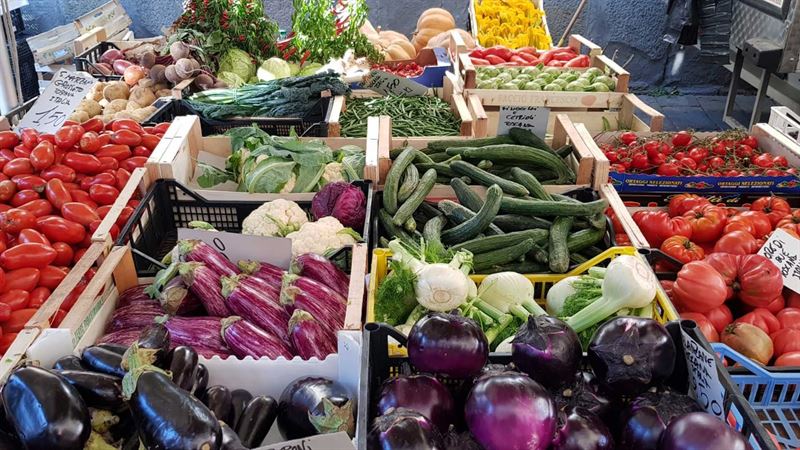
Shopping
Much like the tourism hotspots of San Gimignano and Pienza, tourist tat exists but is still leaves plenty of space for authentic crafts, from art to jewellery, crafts and Tuscan foodstuffs.
-
Galleria Nazionale
Run by the arty Cosignani family, this is a highly tempting gallery, especially for Tuscan art.
Acquire wonderfully moody paintings by Antonio Sbrana, a Tuscan Post-Impressionist artist from the Tuscan tradition of Macchiaioli. The gallery also deals with contemporary, emerging and minimalist Italian artists, along with international artists.
Address: Via Nazionale 4, Cortona
Web: www.gallerianazionale.com -
Delbrenna Jewellery
The Delbrenna jewellery-making business has been going since the early 20th century, based on ancient goldsmith techniques. Come for special handcrafted gifts, from rings to pendants and necklaces, or even bejewelled shoes. You can do a tour of their workshop, olive mill and wine cellars.
Address: Piazza della Repubblica 12, Cortona
Web: https://delbrenna.it/ -
Falegnameria Rossi
Giancarlo Rossi is a third-generation cabinet-maker and carpenter who makes one-off objects from fruit bowls to sculptures of horses and faces, all demonstrating great craftsmanship. The family has been in the wood-carving business since the 1920s.
Address: Via Guelfa 28, Cortona -
Parking
Parking outside the city walls is generally sufficient, except for high summer. Cortona, like most Tuscan towns, operates a strict ZTL system, a Limited Traffic Zone within the city walls. This means that the Centro Storico (historic centre) is essentially closed to traffic, particularly for non-residents. Cars will need to be left outside in the car parks beyond the city walls. The free car park of Parcheggio dello Spirito Santo is a convenient parking spot, especially as an escalator (scala mobile) connects the car park with the historic centre.
Advice on ZTLs: You may see other cars crossing the ZTL boundary (Limited Traffic Zone) and assume you can proceed. Not so. The drivers crossing into the ZTL zone will probably be locals and have residents’ permits. Visitors do not so are liable to fines. Zones are monitored by cameras, so tickets are issued immediately and automatically, as soon as (and each time) the car crosses the ZTL boundary.
See Cortona city website for a downloadable map of parking sites in town:
Web: http://www.comunedicortona.it/il-comune/polizia-municipale/ztl-presentazione1/ztl/ -
Getting there & getting around
Hilltop Cortona may feel in the middle of nowhere and that is part of its charm. In reality, by car is the simplest, with the town on the north-south SS71 route to Arezzo.
Cortona is not the easiest place to reach by rail. The most convenient station is Camucia, 6km southwest of town, and from there a bus service connects with Cortona’s Piazza del Mercato (and from there, buses also run to Arezzo and Castiglion Fiorentino (www.etruriamobilita.it). Camucia train station has no ticket office, only a ticket machine. If this is off-putting, then head to Terentola train station instead, which is 7km south of Cortona, with services to Arezzo every hour (taking 25 minutes) and Florence hourly (taking 1 hour and 45 minutes).

























